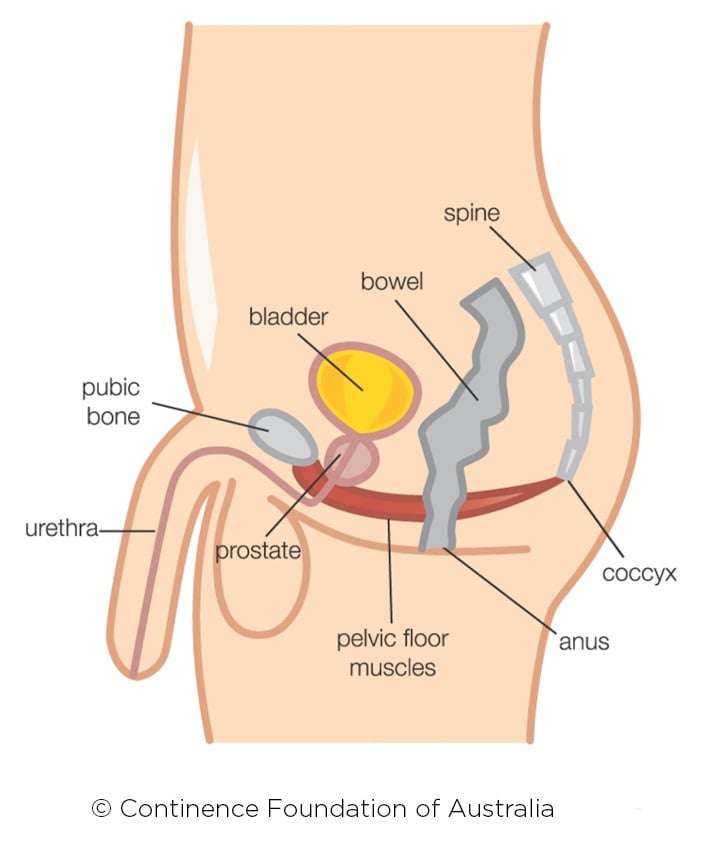What is a hypertonic pelvic floor?
A hypertonic pelvic floor occurs when the muscles in the pelvic floor become too tense and are unable to relax. Many people with a tense and non-relaxing pelvic floor experience pelvic health concerns such as constipation, painful sex, urgency and pelvic pain. A hypertonic pelvic floor may also be accompanied by tension in surrounding hip and pelvic muscles such as the piriformis, obturator internus, coccygeus and hamstrings.


What causes a hypertonic pelvic floor?
There is no one defining cause of a hypertonic pelvic floor; however, there are several activities which can lead to the muscles tightening up. As an example, many people who spend a lot of time working out and holding onto their core muscles can develop tension in their pelvic floor because they keep these muscles switched ‘on’ without giving the muscles times to relax and let go.
People who have a history of holding on to their bladder and/or bowels can also develop tension in their pelvic floor muscles. For instance, some people feel uncomfortable using public toilets so may hold on to their bladders for hours until they come back home from school, work or social activities. The act of holding on means the pelvic floor muscles are tightening to prevent the loss of control.
As high levels of stress, fear or anxiety can cause muscles to reflexively tighten, these factors can lead to a hypertonic pelvic floor. Consider how a puppy behaves when it is afraid—it runs away with its tail between its legs. Similarly, humans have a primitive response during fight or flight where the tailbone tucks under. The pelvic floor muscles are attached to the tailbone and this causes the muscles to shorten.
Pelvic health and abdominal health conditions can also result in hypertonicity of the pelvic floor. For example, many women with endometriosis can develop tense pelvic floor muscles due to the chronic pain and inflammation in the pelvis. Similarly, a history of irritable bowel syndrome with abdominal pain and cramping can result in pelvic floor muscle pain and cramping. Other conditions linked to a hypertonic pelvic floor include interstitial cystitis, pudendal neuralgia and vulvodynia.
Birth trauma and scar tissue is another cause of tightness in the pelvic floor muscles. Women who experience perineal tearing or vaginal tearing may be at a higher risk, as the pain and scarring can cause the pelvic floor muscles to tighten protectively. One-sided pelvic floor tears can cause the opposite side of the pelvic floor to tighten due to overactivity.
It is crucial to identify the cause of the pelvic floor hypertonicity in each individual. A continence physiotherapist will be best equipped to do this.
What are the signs and symptoms of a hypertonic pelvic floor?
The typical sign of a hypertonic or non-relaxing pelvic floor is pelvic muscle pain; however, there are a variety of signs and symptoms, including:
- constipation
- incomplete emptying of the bowels
- straining when emptying the bowels
- pelvic pain
- low back pain
- hip pain
- coccyx pain
- painful sex
- vaginismus
- urinary incontinence
- incomplete emptying of the bladder
- slow flow of urine
- hesitancy or delayed start of urine stream
- urinary urgency
- urinary frequency, and
- painful urination.
What to do if you think you or your client has a hypertonic pelvic floor?
If you have any of the signs or symptoms of a hypertonic pelvic floor, or you have a client that communicates any of these signs or symptoms, seeing a continence physiotherapist is essential. The physiotherapist will be able to identify the root cause of the hypertonicity and provide tools to help overcome this.
A continence physiotherapy session may involve a combination of the following:
- pelvic floor muscle relaxation techniques
- breathing techniques
- advice on bladder and bowel habits
- pelvic floor and abdominal massage techniques
- the use of vaginal dilators for women, to stretch the pelvic floor muscles
- pelvic and hip stretches, and
- scar tissue massage techniques.
Written by Heba Shaheed – physiotherapist, nutritionist and exercise specialist and co-founder and CEO of The Pelvic Expert thepelvicexpert.com.
As a urogynecologist and co-director of the Center for Pelvic Health, I specialize in female pelvic medicine and reconstructive surgery. Here I answer some common questions related to pelvic health and explain how pandemic-related anxieties can affect pelvic health.
What is the pelvic floor and why is it important to take care of it?
The pelvic floor is a complex of muscles and connective tissue structures that support and stabilize the pelvic organs. These include the bladder, urethra, bowel, uterus and vagina. The pelvic floor plays a very important role ensuring that pelvic organs function properly and performs sexual functions, along with the storage and emptying of urine and feces.
Who is affected by pelvic floor disorders?
Women are at much greater risk for pelvic floor disorders than men. The greatest damage to the pelvic floor usually happens during a vaginal birth, so pregnancy and vaginal delivery are significant risk factors. Pressure within the abdomen and pelvis — from chronic constipation, chronic cough, chronic straining during heavy lifting — can contribute to these problems. People with connective tissue disorders, like Ehlers-Danlos or scleroderma, for example, or who have undergone pelvic surgery or radiation, are also at increased risk.
Age is another significant risk factor, since people undergo tissue atrophy as they age.
How does a sedentary lifestyle affect the pelvic floor?
Prolonged sitting, especially in a “wrong” position, can negatively affect the pelvic floor. For example, weakening may happen when sitting in a slouched or relaxed position, or, sitting in another strained position may cause muscle contraction and tightness and result in pelvic pain and lower back pain. Prolonged sitting can potentially damage nerves that can contribute to painful disorders.
Have you had patients complain of pelvic floor issues during the pandemic?
Stress and anxiety can lead to tightening of the pelvic floor muscles, which can result in pain or high-tone pelvic floor dysfunction. Some people have dubbed this phenomenon the “pandemic pelvis.” We know the pandemic has been a high-stress period, and it could contribute to exacerbation of these symptoms in people more prone to anxiety and stress.
What are some signs that your pelvic floor might be in trouble?
When people start noticing leakage of urine with coughing, sneezing, exercising, or subtle small movements, or people experience urinary urgency, this could be a sign to be seen by a doctor. Other warning signs include difficulty emptying the bladder or bowels, losing gas or stool when not desired, or feeling pressure or pain in the pelvic or vaginal area including during intercourse.
If you have digestive problems that persist or often recur, experience frequent constipation or diarrhea, or both, it is time to visit a doctor.
What are some things you can do to help strengthen or protect your pelvic floor?
With people who experience vaginal birth, the more prepared they are, the better. I would compare it to a professional athlete — they recover better from injuries than a non-athletic person because they’re conditioned and prepared.
People can strengthen their pelvic floor muscles before and during pregnancy by doing pelvic floor exercises. During the delivery, pelvic floor muscles should be protected as much as possible and properly repaired if a damage occurs.
There is no gold standard for pelvic floor exercises, but we generally recommend people do Kegel exercises three times per day, with the goal to perform 10 muscle contractions that last 10 seconds each.
We know that exercise keeps us healthy, but we usually ignore the pelvic floor muscles. Just like fitness coaches, there are specialized physical therapists (PTs) for pelvic floor muscles, and those people are the best resource to guide patients through this process.
At the University of Chicago Medicine, we have a multispecialty group within our Center for Pelvic Health, including urogynecologists, urologists, colorectal surgeons, pelvic floor physical therapists, gastroenterologists, minimally invasive gynecologists, and more.
How Stress Affects Your Pelvic Floor
Posted at 11:29h
in
by admin
in Self-care
Stress affects everyone and, while small amounts of stress are a normal part of life, chronic stress is not. But being stressed all the time can do a lot of damage to your emotional wellbeing and, for women, your pelvic floor. Ok, so your pelvic floor might be the last thing you think about when you’ve got a million other things to take care of. We understand but, real talk, your pelvic floor should be something you’re concerned with. A strong, healthy pelvic floor can help you stay in shape, give you confidence, and keep your entire reproductive system operating at it’s best. So how does stress affect your pelvic floor? Read on!

What is Your Pelvic Floor?
Before we dive into how stress actually impacts the health of your pelvic floor, let’s take a look at what your pelvic floor is. In short, your pelvic floor is the muscular base of your pelvis. It’s shaped like a hammock or sling (kind of like one you use to hold a baby in) and, in women, houses the bladder, uterus, and the bowel.
The pelvic floor is what holds all your reproductive muscles in place and allows you to control bladder and bowel urges with the help of sphincter muscles (muscles that contract or relaxed on demand) in the bladder and rectum. To locate your pelvic floor, squeeze as though you are trying to stop yourself from peeing. Feel that? It’s your pelvic floor doing the contracting.
How Stress Affects Your Pelvic Floor
Not all stress is bad stress. In fact, stress is needed for survival and is responsible for the adrenaline rush felt in fight-or-flight situations, like when you find an old sippy cup full of milk under the couch. Kidding (kind of).
On a serious note, stress can cause your pelvic floor to become too tight because, when you’re tense you tend to hold your breath, tighten your muscles, and bear down on your pelvic floor. Add in having a weakened pelvic floor from childbirth and you’ve got a recipe for one stressed out pelvic floor.
Not managing your stress (or the ways that you cope with it) can put you at risk for other pelvic floor complications like urinary incontinence, fecal incontinence, and pelvic organ prolapse. Not your idea of a good time? Ours either.
Symptoms of Pelvic Floor Disorders
The big question is how do you know if your pelvic floor is damaged? Thankfully, there are symptoms that allow us to identify (and then properly treat) a pelvic floor that isn’t doing its job. You could have some or all of these symptoms:
-
Constipation
-
Constantly needing to empty your bowels
-
Urinary problems such as stress incontinence or overactive bladder
-
Pain or pressure in the pelvic area
-
Pain during intercourse
-
Painful urination
-
Lower back pain
-
Inability to control bowel movements
-
Pelvic organ prolapse
How to Relax Your Pelvic Floor (and Your Mind)
Those symptoms sound about as pleasant as having your teeth pulled – as in, not even a little bit. Luckily, managing your stress can help you keep your pelvic floor healthy and keeping your pelvic floor healthy can give you one less thing to stress out about.
To manage your stress:
-
Practice yoga
-
Take deep breaths
-
Get plenty of sleep
-
Stay hydrated
-
Eat a well-balanced diet
-
Stay away from people who stress you out (It’s not always possible but it’s worth a shot!)
-
Delegate responsibilities (like cooking dinner) to other capable adults

To keep your pelvic floor healthy:
-
Use a warm pack or hot towel to help alleviate immediate pain or tension in the pelvic area
-
Take a warm bath
-
Kegel exercises
-
Maintaining a consistent yoga practice
focusing on poses like Malasana, Legs Up the Wall, and Child’s Pose
The idea here is to ease your stress and keep your pelvic floor healthy. Preventative health is a lot easier than trying to fix your health.
Pelvic problems caused by stress can be easily managed, especially if you start right away. The longer you let stress take over your life, the more likely you are to develop pelvic floor conditions that require more treatment than a 10-minute Kegel session.
Don’t you know how to start? Download Bwom and get your own personalized pelvic floor exercises to protect and heal your pelvic area as you need. It just will take you 10 minutes per session and you can prevent and solve problems like urine leaks, discomfort during sex or constipation.
Life is demanding, we know, but take some time out to take care of yourself. Whether it’s daily yoga to help keep your stress levels down or a self-indulgent spa session with friends, listening to your body and what it needs is the optimal route to a healthy life. So go ahead, forget about being superwoman, and give yourself permission to do the best you can. We think you’re great!



